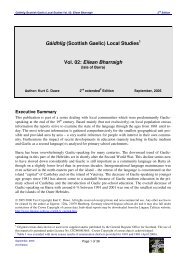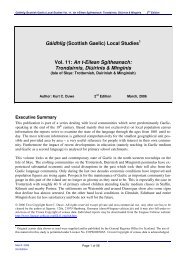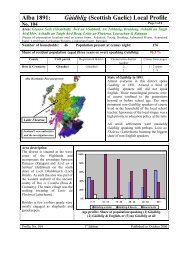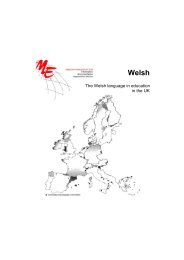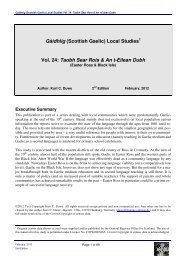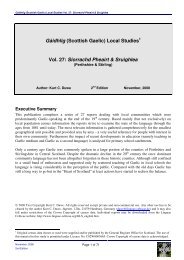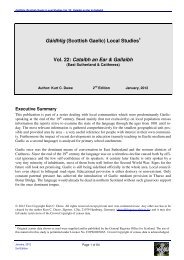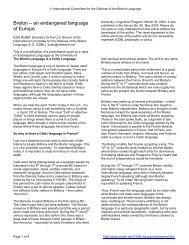Alba 1891: Gąidhlig (Scottish Gaelic) Local Profile - Linguae Celticae
Alba 1891: Gąidhlig (Scottish Gaelic) Local Profile - Linguae Celticae
Alba 1891: Gąidhlig (Scottish Gaelic) Local Profile - Linguae Celticae
You also want an ePaper? Increase the reach of your titles
YUMPU automatically turns print PDFs into web optimized ePapers that Google loves.
<strong>Alba</strong> <strong>1891</strong>: Gàidhlig (<strong>Scottish</strong> <strong>Gaelic</strong>) <strong>Local</strong> <strong>Profile</strong><br />
No. 058<br />
Page 1 of 4<br />
Area: Crothaigh & Dail Chrois (Croy & Dalcross): Càrn Glas, Tir fo Grèine, Crothaigh,<br />
Crothaigh Beag, Tuilm, An t-Ath Dubh, Cnoc na Bà, Baile na Buaile, Canntra, Bràigh<br />
Canntra, Mòine Dail Gramaiche, An Cnoc Cruaidh, An Cnoc Liath & Dail Chrois<br />
(Names of enumeration locations used on census forms : Wester Cairnglass, Tirfogrein, Croy Village, Little Croy,<br />
Holme Rose, Mains of Croy, Blackford, Knocknaba, Balnabual, Cantray, Brae of Cantray, Dalgramich Moor, Little<br />
Dalcross, Glebe of Dalcross, Hardhill, Greyhill & Dalcross)<br />
Number of households: 74 Population present at census night: 335<br />
Share of resident population (aged three years or over) speaking Gàidhlig: 48.9 %<br />
County Civil parish Registration district Enumeration district<br />
number<br />
Inverness Croy & Dalcross Croy & Dalcross<br />
3<br />
Nairn<br />
Croy<br />
<strong>Alba</strong> (Scotland): Past and present<br />
Crothaigh<br />
Scotland’s new authorities<br />
and the investigation area<br />
Area description:<br />
The district covered lies to the east<br />
of the city of Inbhirnis (Inverness)<br />
on the coastal plain between the<br />
counties of Narann (Nairn) and<br />
Inbhirnis (Inverness). The<br />
settlements include the village of<br />
Crothaigh (Croy) and a number of<br />
smaller hamlets and farms.<br />
At the time of the census<br />
agriculture was the dominant<br />
factor in the life of the<br />
population.<br />
Croy & Dalcross<br />
100%<br />
80%<br />
60%<br />
40%<br />
20%<br />
0%<br />
3<br />
Census form pages<br />
1 – 4(part), 5,<br />
6(part), 8 - 15<br />
4(part),6(part),7<br />
State of Gàidhlig in <strong>1891</strong>:<br />
The language was already on the decline at<br />
this time. Generations born before 1870<br />
were still predominantly speaking the<br />
Gàidhlig language, but the younger people<br />
were mostly monolingual English speakers.<br />
Just five persons in the area spoke “<strong>Gaelic</strong><br />
only”. They were all advanced in age.<br />
The strength of the language was far from<br />
being uniformly distributed over the area.<br />
On some farm holdings like Tuilm (Holm)<br />
the traditional tongue was almost absent<br />
whereas some crofting communities near<br />
Dail Gramaiche (Dalgramich) were<br />
overwhelmingly Gàidhlig speaking.<br />
3 - 9 10 - 14 15 - 24 25 - 44 45 - 64 65+<br />
Gàidhlig a mhàin Gàidhlig & Beurla Beurla is eile<br />
Age profile: Share of population speaking (1) Gàidhlig,<br />
(2) Gàidhlig & English, or (3) no Gàidhlig at all<br />
<strong>Profile</strong> No. 058 1 st Edition Published in May 2006
<strong>Alba</strong> <strong>1891</strong>: Gàidhlig (<strong>Scottish</strong> <strong>Gaelic</strong>) <strong>Local</strong> <strong>Profile</strong><br />
No. 058<br />
Page 2 of 4<br />
Area: Crothaigh & Dail Chrois (Croy & Dalcross): Càrn Glas, Tir fo Grèine, Crothaigh,<br />
Crothaigh Beag, Tuilm, An t-Ath Dubh, Cnoc na Bà, Baile na Buaile, Canntra, Bràigh<br />
Canntra, Mòine Dail Gramaiche, An Cnoc Cruaidh, An Cnoc Liath & Dail Chrois<br />
Age<br />
Population enumerated Usually resident population (3+)<br />
Total Aged<br />
0-2<br />
Deaf<br />
&<br />
dumb<br />
Visitors<br />
etc. 3<br />
Total 4 Gàidhlig Gàidhlig<br />
&<br />
English<br />
Gàidhlig<br />
speakers<br />
(%)<br />
Total 335 21 0 9 305 5 144 48.9 %<br />
3-4 16 0 0 16 0 0 0.0 %<br />
5-9 44 0 1 43 0 3 7.0 %<br />
10-14 43 0 0 43 0 7 16.3 %<br />
15-24 47 0 1 46 0 20 43.5 %<br />
25-44 82 0 2 80 0 51 63.8 %<br />
45-64 56 0 3 53 2 42 83.0 %<br />
65+ 26 0 2 24 3 21 100 %<br />
Gender<br />
Female 176 11 0 3 162 4 83 53.7 %<br />
Male 159 10 0 6 143 1 61 43.4 %<br />
Place of birth<br />
Born in parish 158 21 0 2 135 0 60 44.4 %<br />
In neighbouring parish 1 33 0 0 1 32 1 16 53.1 %<br />
Gaidhealtachd elsewhere 2 65 0 0 2 63 4 52 88.9 %<br />
Other places 79 0 0 4 75 0 16 21.3 %<br />
Notes:<br />
1<br />
Parishes of Petty, Daviot & Dunlichity, Moy &<br />
Dalarossie (all Inverness) or Croy and Cawdor<br />
(both Nairn).<br />
2<br />
Other parishes in Scotland with more than 50 %<br />
Gàidhlig speakers in the <strong>1891</strong> census.<br />
3<br />
People described as visitors, boarders, lodgers or<br />
other similar terms.<br />
4<br />
Number of enumerated persons who were (1)<br />
older than 2 years of age, who were (2) not deaf<br />
& dumb and who (3) did not live only temporarily<br />
in the area.<br />
Gàidhlig a mhàin<br />
Gàidhlig & Beurla<br />
Beurla is eile<br />
Share of population speaking (1) Gàidhlig,<br />
(2) Gàidhlig & English, or (3) no Gàidhlig at all<br />
Background of Gàidhlig (<strong>Scottish</strong> <strong>Gaelic</strong>) <strong>Local</strong> <strong>Profile</strong>s:<br />
The <strong>1891</strong> census was the first such enumeration exercise with an unequivocal language question. After<br />
more than 100 years the original census forms are publicly available for detailed analysis. During research<br />
concerned with the “Gàidhlig (<strong>Scottish</strong> <strong>Gaelic</strong>) <strong>Local</strong> Studies” a vast number of such local statistics have<br />
been gathered about the Gàidhlig speaking population of Scotland in that year. As many of these results<br />
could not be included in the reports these concise fact-sheets are a welcome way to publish some of the<br />
“local gems”. More information is provided at http://www.linguae-celticae.org/GLP_english.htm .
<strong>Alba</strong> <strong>1891</strong>: Gàidhlig (<strong>Scottish</strong> <strong>Gaelic</strong>) <strong>Local</strong> <strong>Profile</strong><br />
No. 058<br />
Page 3 of 4<br />
Area: Crothaigh & Dail Chrois (Croy & Dalcross): Càrn Glas, Tir fo Grèine, Crothaigh,<br />
Crothaigh Beag, Tuilm, An t-Ath Dubh, Cnoc na Bà, Baile na Buaile, Canntra, Bràigh<br />
Canntra, Mòine Dail Gramaiche, An Cnoc Cruaidh, An Cnoc Liath & Dail Chrois<br />
House- Usually resident population (3+)<br />
holds Total Gàidhlig Gàidhlig & Gàidhlig<br />
English speakers<br />
(%)<br />
Crothaigh & Dail Chrois 74 305 5 144 48.9 %<br />
Individual communities<br />
Càrn Glas & Tir fo Grèine<br />
(Cairnglass & Tirfogrein)<br />
Crothaigh & Crothaigh Beag<br />
(Croy & Little Croy)<br />
An Tuilm 1<br />
(Holme Rose)<br />
An t-Ath Dubh & Baile na Buaile<br />
(Blackford & Balnubual)<br />
Canntra<br />
(Cantray)<br />
Bràigh Canntra<br />
(Brae of Cantray)<br />
Mòine Dail Gramaiche<br />
(Dalgramich Moor)<br />
Dail Chrois<br />
(Dalcross)<br />
3 19 0 2 10.5 %<br />
20 81 0 41 50.6 %<br />
11 46 0 13 28.3 %<br />
9 26 1 17 69.2 %<br />
12 45 0 25 55.6 %<br />
6 27 2 11 48.1 %<br />
5 25 2 16 72.0 %<br />
8 36 0 19 52.8 %<br />
1 The farmland of Holme Rose was transferred in <strong>1891</strong> from the county of Inverness to the county of Nairn.<br />
Language of parents<br />
Both parents Gàidhlig speaking 14 75 2 42 58.7 %<br />
Single parent Gàidhlig speaking 6 27 0 20 74.1 %<br />
One parent Gàidhlig speaking 8 50 0 9 18.0 %<br />
No Gàidhlig speaking parent 8 39 0 2 5.1 %<br />
Households with no children (0-14) 38 114 3 71 64.9 %<br />
Occupation of head of household<br />
Crofter, farmer, fisherman, etc. 19 86 3 54 66.3 %<br />
Shepherd, gamekeeper or similar 6 21 0 13 61.9 %<br />
Clergyman, teacher, physician, etc. 5 22 0 7 31.8 %<br />
Mason, carpenter, merchant, etc. 8 41 0 14 34.1 %<br />
Living on private means 1 6 0 2 33.3 %<br />
Manager, coachman, cook, etc. 3 15 0 4 26.7 %<br />
Worker, farm/domestic servant, etc. 32 114 2 50 45.6 %<br />
Remaining occupations 0 0 0 0 -<br />
© Text and statistics: Copyright Kurt C. Duwe. All rights reserved except private and non-commercial<br />
use. Any other use has to be cleared by the author Kurt C. Duwe, Jägerstr. 120a, 21079 Hamburg,<br />
Germany (duwe@linguae-celticae.de) and it may also fall under restrictions of the Crown Copyright of<br />
census data. Statistics have been derived from <strong>1891</strong> census returns published by the General Register<br />
Office for Scotland (GROS). The use of this material here is permitted under Licence No.<br />
C02W0003665. Crown Copyright of census data is acknowledged. The digital boundaries shown on the<br />
Scotland map are courtesy of Ordnance Survey as part of the Geography Products provided by GROS.<br />
Additional individual profiles may be downloaded from a special page on the <strong>Linguae</strong> <strong>Celticae</strong> website:<br />
http://www.linguae-celticae.org/GLP_english.htm
<strong>Alba</strong> <strong>1891</strong>: Gàidhlig (<strong>Scottish</strong> <strong>Gaelic</strong>) <strong>Local</strong> <strong>Profile</strong><br />
No. 058<br />
Page 4 of 4<br />
Area: Crothaigh & Dail Chrois (Croy & Dalcross): Càrn Glas, Tir fo Grèine, Crothaigh,<br />
Crothaigh Beag, Tuilm, An t-Ath Dubh, Cnoc na Bà, Baile na Buaile, Canntra, Bràigh<br />
Canntra, Mòine Dail Gramaiche, An Cnoc Cruaidh, An Cnoc Liath & Dail Chrois<br />
Place of birth and Gàidhlig speaking:<br />
Almost 50 % of the nearby born residents<br />
still spoke Gàidhlig. Whereas most people<br />
born in the wider Gaidhealtachd spoke the<br />
language, too, those born elsewhere were<br />
most likely to be English monolinguals.<br />
Notes:<br />
1 Born either in Croy & Dalcross or in the<br />
adjacent parishes of Petty, Daviot & Dunlichity,<br />
Moy & Dalarossie (all Inverness) or Croy and<br />
Cawdor (both Nairn).<br />
2 Born in other parishes of Scotland with more<br />
than 50 % Gàidhlig speakers in the <strong>1891</strong> census.<br />
Remarks<br />
100%<br />
80%<br />
60%<br />
40%<br />
20%<br />
0%<br />
Nearby Gaidhealtachd Elsewhere<br />
Gàidhlig a mhàin Gàidhlig & Beurla Beurla is eile<br />
Speakers according to place of birth (1) nearby 1<br />
(2) in remaining Gaidhealtachd 2 , or (3) elsewhere<br />
1. Just five persons in the area spoke “<strong>Gaelic</strong> only”. They were all advanced in age.<br />
2. At the time of the census several county boundaries were still very fragmented and a number<br />
of small enclaves existed in several counties. This was especially the case in districts of<br />
Inverness-shire and Nairnshire. For example the farmland of Holme Rose was transferred in<br />
<strong>1891</strong> from the county of Inverness to the county of Nairn.<br />
3. Official census figures re ported 148 bilingual inhabitants and 5 monolingual Gàidhligspeakers<br />
out of a total population of 335 persons (45.7 %). The usually resident population<br />
consisted of 149 Gàidhlig-speakers (48.9 %) including five persons “with no <strong>Gaelic</strong>”.<br />
<strong>Profile</strong> No. 058 1 st Edition Published in May 2006



